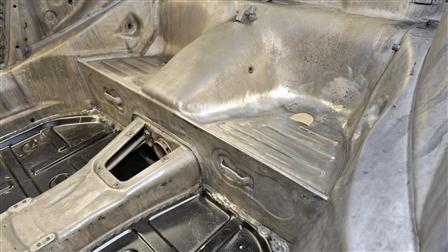
Body Work: Reconstruction
The perfect form: The 911T now has its original shape and gap dimensions once more
The clear lines and contours are now visible again. The
“Revive the Passion”, the joint project of
The winner can already look forward to a completely new classic car, a car embodying a level of beauty that will withstand any critical examination. The form is perfect and the gap dimensions are correct. After completing the complex body work, this accuracy is the most important achievement for the employees in the
This sounds easier than it is, particularly when the last crucial millimetres are involved. The work requires a good eye, patience and precision. Above all, however, an original straightening bench is needed, and only
For the 911 T, the experts completed the front end with a new end section, including battery boxes, fuel tank support and closing panel. New wings and side sections were also fitted on the left and right. The new underbody was fixed in position and the seat recess behind the driver replaced. Since this part is no longer available, the mechanics produced it once more on the basis of original drawings. The side supports under the B-pillar were also replaced. These parts cannot be seen but are needed for body reinforcement. The body becomes “soft” if these parts are rusted or damaged.
After completion of the welding work, all seams and joints are subjected to a special treatment.
The tin is heated, applied to the corresponding locations, smoothed with wood and then ground flat with a special tin plane.
The specialists also paid great attention to the doors. While the door frames of the original vehicle were preserved, new door panels were fitted. In addition to the doors, it was also necessary to fit and align the headlights, tail lights, engine lid and luggage compartment lid. To do this, the experts first mounted all locks and rubber damping elements on the corresponding parts. Exact production of the original gap dimensions is a science in itself. Working on the straightening bench is particularly important for this operation. This is because only a straightening bench allows a bodyshell to be fixed in such a way that it behaves exactly like a complete vehicle with engine in the rear that is standing on the road on four wheels.
For a
The headlights, lights, locks and rubber elements are then removed from the bodyshell again. On its journey back onto the road, the 911 T has therefore now achieved its perfect form down to the very last gap dimension. All preparations for cathaphoretic dip painting are thus complete. This is also how things have to be, because it is practically no longer possible to change any of the form and joint details after uniform and thorough priming with the electrically charged fluid.








































